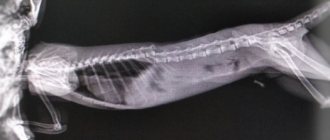All representatives of the cat family are distinguished by natural dexterity and grace, but this property is not always able to protect them from injury. In addition, the world is full of unkind people who may not like these furry fidgets, and therefore are quite capable of causing them intentional harm. Therefore, every responsible owner should be aware of what a concussion is in cats.
Veterinarians note that concussion is not an independent disease, but is only a consequence of the injury received. However, it should not be underestimated, since as a result of a head injury, the animal may experience hemorrhage in the brain or its compression inside the skull. All this leads to dangerous dysfunction of the motor and central nervous systems, which affects the entire life activity of the tailed friend.
The insidiousness of a concussion is that it may not manifest itself in any way for quite a long time, and then suddenly the cat begins to have seizures or develop chronic heart disease on its own. Therefore, owners should remember that even the most insignificant at first glance head injury to a mustachioed friend can have very serious consequences. The article will discuss the causes of a concussion in a cat, and will also discuss the symptoms and treatment of this disease.
Causes of the disease
Statistics show that the most common causes of a concussion in a cat are:
- Collision with road vehicles: cars, motorcycles, scooters and even bicycles.
- Falling from a great height, unsuccessful landing when jumping from a tree to the ground. This is especially true for those pets who have the right to walk freely wherever they please. However, domestic cats are also at risk, as they often fall off balconies and window sills. Most often this happens in the summer, when apartment windows are wide open.
- Deliberate harm by hooligans. Unfortunately, in our time there are still enough people walking the streets of the city who find pleasure in inflicting pain on a weaker creature.
- Heavy objects falling on your pet's head. Such injuries are most dangerous for a small kitten, which simply will not have time to orient itself in the current situation and will not jump to the side. In addition, his skull is not yet strong enough, which means the consequences of the accident could be disastrous.
- In pursuit of prey, a furry predator is capable of reaching such a level of excitement that it may simply not notice a suddenly arising obstacle and slow down in front of it.
- Sometimes the owners themselves cause head injuries to a mustachioed friend by opening the door too sharply or accidentally stepping on the cat while it was sleeping.
Initial activities
MRI, CT (if available);
X-ray of the chest, skull in two projections, cervical spine; IMPORTANT! Every tenth patient with severe TBI also has damage to the cervical spine. Until spinal injury is ruled out, the animal should be managed as having a spinal injury.
Laboratory tests: complete blood count, blood glucose, blood gases and electrolytes, creatinine and blood urea, complete urinalysis; monitoring: general clinical – blood pressure, heart rate, respiratory rate, ECG, blood saturation; neuromonitoring – ICP, EEG, transcranial Doppler echography.
Symptoms of the disease
The main symptom of a concussion in cats is that when an injury occurs, the animal immediately loses consciousness. The pet “passes out” for a couple of minutes, and when it comes to its senses, it looks stunned. He may have short-term memory loss; at first he may not recognize the owner, run away from inspection attempts, and even attack the owner. It is important to understand that the longer the pet lies unconscious, the stronger the concussion.
The main signs of a concussion consist of the following characteristic manifestations:
- the eyeball begins to tremble (nystagmus);
- the pet’s pupils have different sizes and react poorly to light stimuli;
- the mucous membranes become excessively red, or, conversely, turn pale;
- coordination of movements is impaired;
- the respiratory process is disrupted, wheezing is heard when exhaling;
- due to a severe headache, the cat rests its muzzle against the wall;
- apathy and loss of interest in food;
- vomit;
- the cat's limbs twitch involuntarily;
- you can find a hematoma or bruises on your pet’s head;
- paw paralysis
The stronger the injury, the more severe the symptoms. However, even if signs practically do not appear, this does not mean that your furry friend does not need to be shown to the veterinarian as soon as possible. If this is not done immediately after a concussion, the pet faces the risk of disruption of proper blood circulation in this organ, an increase in intracranial pressure, as well as hemorrhage in the brain, which can turn it into a disabled person.
Diagnosis of the condition
In a specialized institution, the veterinarian will first of all collect a detailed medical history. A thorough clinical examination will help to suspect brain damage in a furry patient. During it, the specialist will assess the degree of damage to the eye lens, the condition of the mucous membranes, and the nature of neurological disorders.
If necessary, the animal will undergo an X-ray examination of the skull. Modern equipped veterinary clinics also use magnetic resonance and computed tomography.
First aid
So, the owner has witnessed that his pet has suffered a head injury and is unconscious, what to do in such cases? First of all, veterinarians recommend carefully moving the cat to a quiet room without bright sources of light and laying it on its side. The main condition is not to try to revive your pet yourself using ammonia or cold water. He must come to consciousness on his own.
If your tongue gets stuck, protect your furry friend from suffocation by using a clean cloth or napkin to try to pull him out of the cat’s mouth. Such a measure is also necessary as insurance against the animal choking on vomit. If there is a clearly visible, open wound on the head, try to rinse it with warm water and then treat it with an antiseptic. Apply a cold compress to the injury site.
Monitor the cat's heartbeat; in case of cardiac arrest, perform artificial respiration and massage this organ. Do not forget that as a result of the resulting concussion, the cat may quite possibly not recognize its owner for 1-2 days. Be patient and don't get upset by the animal's aggressiveness.
Transportation of the mustachioed friend to the veterinary hospital is carried out on a hard surface. Under no circumstances should you use a carrier; it is better to carry the cat in your arms, trying to keep the pet on its side. The most ideal option is a cardboard box with a wide bottom. Lying in it, the animal does not experience severe shaking, which means that the risk of a sudden onset of brain hemorrhage will be insignificant.
Traumatic shock
Traumatic shock is considered one of the most dangerous conditions in cats. It is the most common cause of death in animals.
Signs of traumatic shock
Shock in a cat can be determined by the following signs:
- change in heartbeat (increased or slowed down);
- breathing became faster;
- gums become pale (may become completely white);
- body temperature has decreased.
If you find no external damage to your pet, shock may be caused by bleeding or internal damage.
First aid for a cat with traumatic shock
An injured cat needs immediate help. To begin, place the cat on its side on a pre-spread towel (or diaper). If necessary, open its airways: place your palm under the animal's head so that the index finger and thumb are above its upper fangs. Then tilt your head lying on your palm so that the animal’s nose is directed upward. Squeeze your fingers very gently, after which the cat’s mouth will open slightly. Gently pull your pet's tongue with your other hand, thereby opening the airway.
Place a rolled-up towel or small pillow under the cat's hind legs and hips - the back of the cat's body should be elevated.
Carefully examine the animal, if you find external bleeding, stop it.
Treatment of the disease
After examining the patient and establishing an accurate diagnosis, the veterinarian prescribes treatment. Primary therapy is aimed at reducing cerebral edema in a cat; the drugs Hypothiazide and Indapamide, as well as diuretics such as Furosemide and Veroshpiron, are excellent for these purposes. The pet is also prescribed pharmaceuticals with a pronounced analgesic effect, for example, Analgin, and injections that can support the functioning of the cardiac system (caffeine).
Immediately after swelling and the most painful symptoms are removed, the doctor prescribes nootropic drugs (Piracetam, Glycine) for the cat, which improve metabolism in brain tissue and nourish nerve cells. In addition, the cat is prescribed mild sedatives, such as Fitex and Xylazine, as well as those based on medicinal herbs - motherwort, peppermint. The duration of medication is determined by how severe the cat's concussion was. On average, complete healing takes from 7 to 14 days.
Never try to treat an animal at home. Even experienced veterinarians cannot always understand all the nuances of a concussion without the use of X-rays or CT scans. Caring for an injured pet on your own without first consulting a doctor will probably only aggravate the current situation and lead the cat to irreversible disorders of the functioning of the brain.
Spinal injuries and their consequences
The spine in cats is injured quite often, but the consequences can be completely different. If we are talking about bruises, then over time the functions are restored and the animal continues to live a full life. It is much worse when a fracture of the spine occurs with rupture and damage to the nerve endings and spinal substance. In this case, the cat may remain spinal for the rest of its life, which means that the back of its body will be paralyzed. After such an injury, the cat experiences fecal and urinary incontinence, paralysis of the hind limbs and tail, while the animal is able to move on its front legs, eat and can live quite a long time. Sometimes complex spinal surgery helps solve the problem, but in most cases, it is not possible to restore all functions. As a warning to owners, it is worth saying that such conditions arise not only as a result of falls or car injuries; the cause can be a simple animal getting stuck in a plastic window. In the summer, many people leave windows in vertical ventilation mode, when the upper part of the window is open but the lower part is not. Since apartment cats often like to hunt birds and insects flying by, as well as for the sake of curiosity, they jump into the resulting gap and get stuck in it. Attempts to get out end with the animal getting stuck even more, and compression occurs, disrupting hemodynamics in the body. As a result, tissues and organs do not receive sufficient blood supply and lose their function. The longer the cat spends in this position, the worse the prognosis for recovery.
Cat care
A cat that has suffered a concussion needs careful care and attention from the owner. The following recommendations will help ensure a quick recovery:
- The animal must be in a state of peace and quiet. Loud sounds and bright lights are contraindicated for him.
- Feed your cat healthy food rich in vitamins and microelements.
- Until complete recovery, you should not let your pet go outside.
- Over the next 4-6 months, take your pet to the vet regularly.
There is little pleasure in brain injuries, and they are extremely dangerous for a furry fidget. Therefore, at the first sign of a concussion, the pet should be taken to a veterinary clinic as quickly as possible. It also happens that if the owner ignores even the slightest, seemingly insignificant bruises to the head of his pet, he remains disabled for life. Feel free to take care of your cat and take care of his health, and he will always be cheerful and energetic.
Forecast
The prognosis depends on the severity of the disease, the area of injury and its degree. Coma that lasts more than 48 hours or a progressive deterioration of the condition is considered to have a poor prognosis.
Cats who have suffered a TBI should be regularly examined by a neurologist to monitor the dynamics and correct the prescribed therapy. Some patients recover quite slowly and the extent of their recovery cannot be predicted
Neurological signs can persist in cats for almost months and it is important to be patient, follow all recommendations of a veterinarian, provide a high-quality diet and good care
Read reviews about our veterinary center. Call the number and schedule a consultation right now or request a call back. (c) Veterinary center for the treatment and rehabilitation of animals “Zoostatus”. Varshavskoe highway, 125 building 1.










